Figure 8-1: The Circle of Fifths shows the relationship between major keys and their relative minors.
Chapter 8
Key Signatures and the Circle of Fifths
In This Chapter
 Studying the Circle of Fifths
Studying the Circle of Fifths
 Exploring the major and minor key signatures
Exploring the major and minor key signatures
 Examining the major and minor keys
Examining the major and minor keys
At the beginning of most pieces of written music, you’ll find a group of sharps or flats located directly to the right of the time signature. This group of symbols is called the key signature, and it tells you what key the song is written in.
When you know a song’s key, or the scale that the set of notes used to compose the song you’re playing comes from, you may find reading the music easier. You can anticipate the notes on the sheet music based on your knowledge of the scales and the notes in those keys. Also, in a situation where you’re playing with other musicians, if you know the key you’re playing in and can anticipate the chords, you can guess where the melody of the song is going. It’s almost like knowing what word is going to come next — or at least what limited selection of words could come next — to fit into a sentence.
In this chapter, you find out all about key signatures and how to recognize them on sight. You also read about Pythagoras’s Circle of Fifths and how to use it to read key signatures. Finally, we round out the chapter with a discussion about major and minor key signatures and their relative minors and majors.
Understanding the Circle of Fifths
In the sixth century B.C., the Greek scholar and philosopher Pythagoras decided to try and make things easier for everyone by standardizing, or at least dissecting, musical tuning. He had already discovered the relationship between pitch frequencies and lengths of string and had defined what an octave was, so he figured standardizing tuning was the next logical step.
He divided a circle into 12 equal sections, like a clock. The result of his experimentation eventually became known as the Circle of Fifths, which is still used today. Each of the 12 points around the circle was assigned a pitch value, which roughly corresponds to the present system of an octave with 12 half steps. Western music theorists have since updated Pythagoras’s Circle of Fifths to what you see in Figure 8-1. We discuss this circle further in the next section.
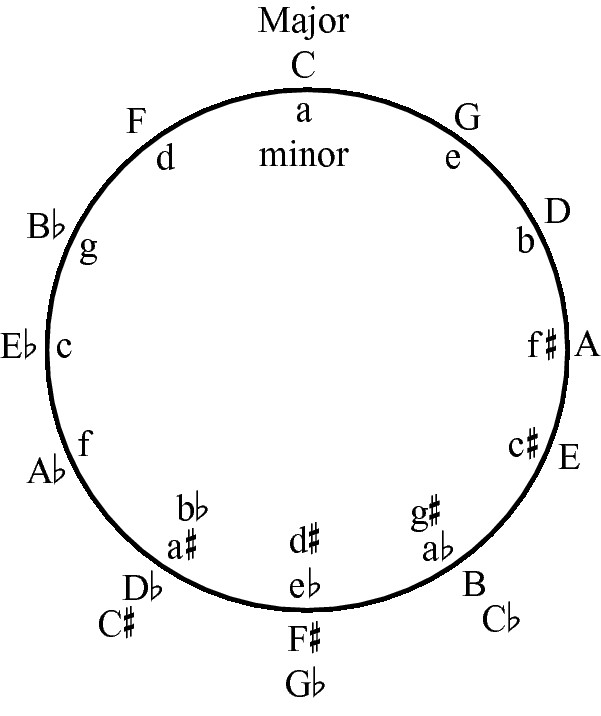
The creation and use of the Circle of Fifths is the very foundation of modern Western music theory, which is why we talk about it so much in this book. Figure 8-2 shows a slightly different version of the Circle of Fifths than is shown in Figure 8-1. The former figure can be used to help you learn to read key signatures on sight by counting the sharps or flats in a time signature.
The Circle of Fifths helps you figure out which sharps and flats occur in the different keys. The name of the key being played is the letter on the outside of the circle. To figure out how many sharps are in each key, count clockwise from C at the top of the circle.
Figure 8-2: The Circle of Fifths tells you how many sharps and flats are in the key signatures and scales of each key.
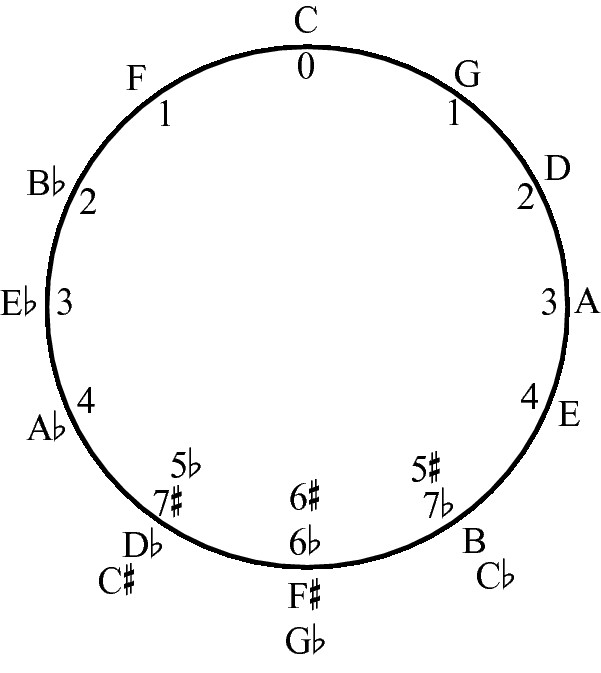
C major has a number value of 0, so it has no sharps. G has a value of 1, so it has one sharp. When you play the G major scale on the piano, you play only white keys until you come to the seventh interval and land on that one sharp: F sharp, in this case. D has two sharps, A has three, and so on around the circle. The number value by each letter on the right-hand side of the circle represents how many sharps are in that key, which is determined by that key’s scale.
Along with all the technical things the Circle of Fifths predicts, it’s also your best friend for deciphering key signatures on sight. It’s just as essential in writing music, because its clever design is helpful in composing and harmonizing melodies, building chords, and moving to different keys within a composition.
Sharps: Father Charles Goes Down and Ends Battle
For example, if you’re playing a song in the key of B major, you know from the Circle of Fifths that B major has five sharps. And you know from the Father Charles mnemonic that those sharps are F sharp, C sharp, G sharp, D sharp, and A sharp, because the sharps are always in that order. If you’re playing the key of D major, which has two sharps, you know those sharps are F sharp and C sharp because Father Charles. . . . If you have a better mnemonic than the one we suggest, feel free to use it.
Flats: Battle Ends And Down Goes Charles’s Father
For the major scales and keys with flats, you move counterclockwise around the Circle of Fifths (refer to Figure 8-2), starting at C, which still has a number value of 0. Therefore, the key of F major has one flat, the key of B flat major has two flats, and so on.
So, G flat, for example, which is six steps away from C major on the circle, has six flats in its scale, and they are B flat, E flat, A flat, D flat, G flat, and C flat. The key of B flat, which is two steps away from C at the top of the circle, has B flat and E flat in its key. Notice that the orders of sharps and flats given in the mnemonics are exactly the order in which they are written in key signatures.
Recognizing Major Key Signatures
To figure out how many sharps are in each key signature, count clockwise on the Circle of Fifths (see Figure 8-2) from C major. The number of sharps in each successive key goes up by one in that key’s key signature. At G, one “stop” from C major, there’s one sharp in the key signature. At D, two stops from C, there are two sharps in the key signature. See Figure 8-3 to see the sharps going “up.”
Figure 8-3: The sharps are arranged in the key signature going “up.”
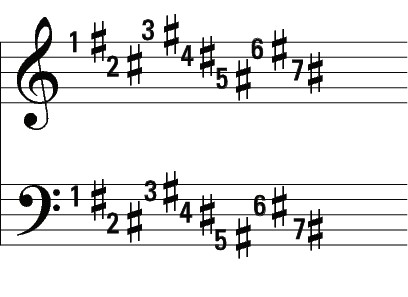
Therefore, if you’re playing a song in the key of B major, which is located five stops from the C major on the circle, you know that key has five sharps. But also, if you know the mnemonic Father Charles Goes Down And Ends Battle, you know that those five sharps in B major are F sharp, C sharp, G sharp, D sharp, and A sharp. If you’re playing in the key of D major, which has two sharps, you know those sharps are F sharp and C sharp.
For major scales that have flats, you go counterclockwise around the Circle of Fifths. The flats appear in a specific order in every key as you go from C around the circle counterclockwise: B flat, E flat, A flat, D flat, G flat, C flat, and F flat. (You know this if you remember the mnemonic Battle Ends And Down Goes Charles’s Father.) Going counterclockwise, F, which is one stop from C major, has one flat in the key signature; B flat, which is two stops from C major, has two flats in the key signature (and so on around the circle). Figure 8-4 shows the flats going “down.”
Figure 8-4: The flats are arranged in the key signature going “down.”
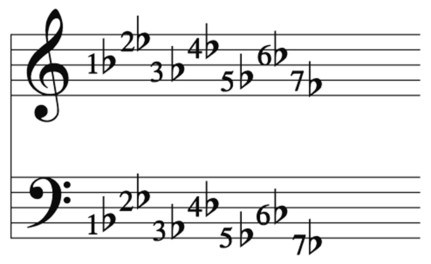
So, for example, G flat, which is six steps away from C major on the circle, has six flats in its key signature. And because you know the mnemonic Battle Ends And Down Goes Charles’s Father, you know that those flats are B flat, E flat, A flat, D flat, G flat, and C flat. B flat, which is two steps away, has two flats, and now you know those flats have to be B flat and E flat.
Finding Minor Key Signatures and Relative Minors
The Circle of Fifths works the same way for minor keys as it does for major keys. The minor keys are represented by the lowercase letters inside the Circle of Fifths shown in Figure 8-1.
For example, C major’s relative minor is A minor (refer to Figure 8-1, the Circle of Fifths where C is on the outside and A is on the inside of the circle). A minor’s tonic note is A, which is three half steps to the left of C on the piano or three frets toward the head of the neck on the guitar.
Even the Father Charles . . . and Battle Ends . . . mnemonics stay the same when you’re dealing with minor keys. That’s because no difference exists in the key signature between a major key and its relative minor.
On sheet music, the relative minor is the note one full line or space below the major key note. C is in the third space on the treble clef, and A, its relative minor, is in the second space, below it.
Reviewing the Key Signatures
In the following sections, we provide a rundown of the major and natural minor key signatures and a couple of octaves’ worth of notes in those keys, arranged in a scale. Because this chapter focuses on the Circle of Fifths, we order the key signatures following the circle, as opposed to alphabetical order.
C major and A natural minor
Figure 8-5 shows the C major key signature, and Figure 8-6 shows the A natural minor key signature, C’s relative natural minor.
Figure 8-5: The C major key signature and scale.
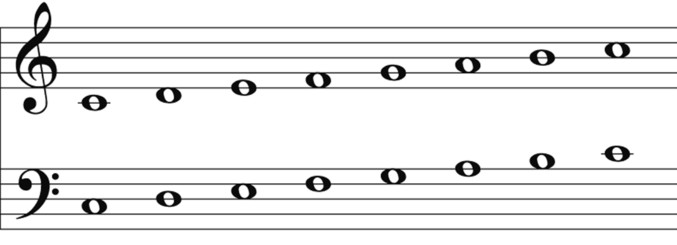
Figure 8-6: The A natural minor key signature and scale.
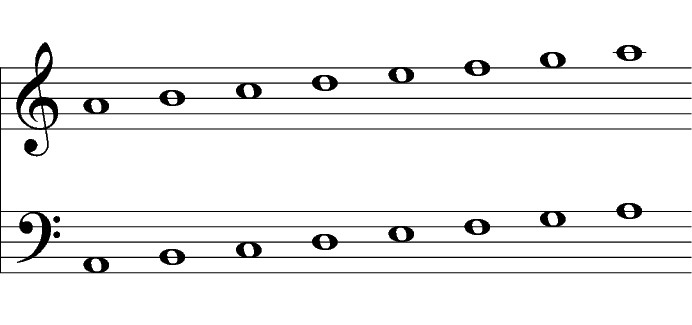
As you can see, the C major and the A natural minor have the same key signature (that is, no sharps and no flats) and the same notes in the scale because A is the relative natural minor of C. The only difference is that the C major scale starts on C, whereas the A natural minor scale starts on A.
G major and E natural minor
Figure 8-7 shows the G major key signature, and Figure 8-8 shows the E natural minor key signature, G’s relative natural minor.
Figure 8-7: The G major key signature and scale.
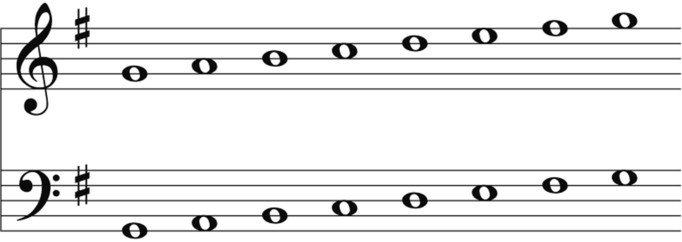
Figure 8-8: The E natural minor key signature and scale.
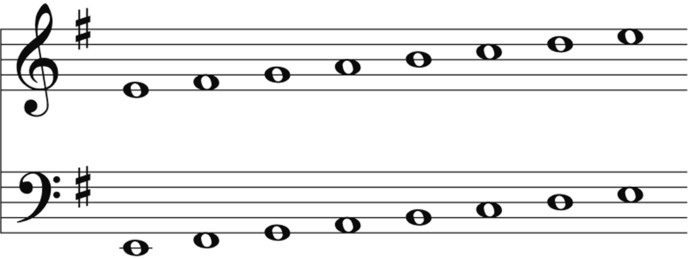
You’ve now added one sharp (F) to the key signature. The next stop (D) has two (F and C, because Father Charles. . .), and you keep adding one more sharp until you get to the bottom of the Circle of Fifths.
D major and B natural minor
Figure 8-9 shows the D major key signature, and Figure 8-10 shows the B natural minor key signature, D’s relative natural minor.
Figure 8-9: The D major key signature and scale.
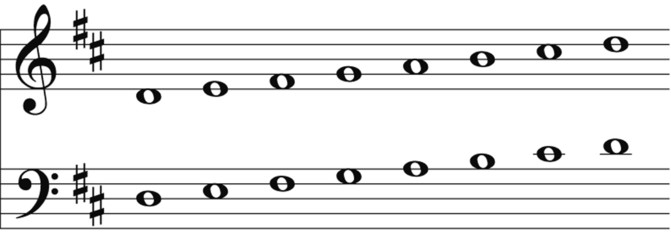
Figure 8-10: The B natural minor key signature and scale.
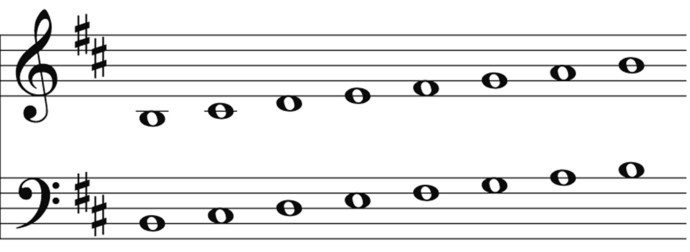
A major and F sharp natural minor
Figure 8-11 shows the A major key signature, and Figure 8-12 shows the F sharp natural minor key signature, A’s relative natural minor.
Figure 8-11: The A major key signature and scale.
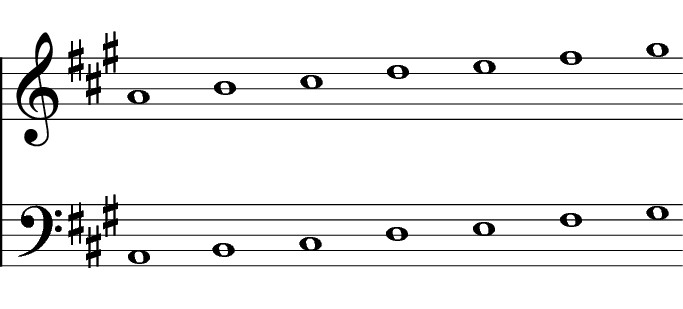
Figure 8-12: The F sharp natural minor key signature and scale.
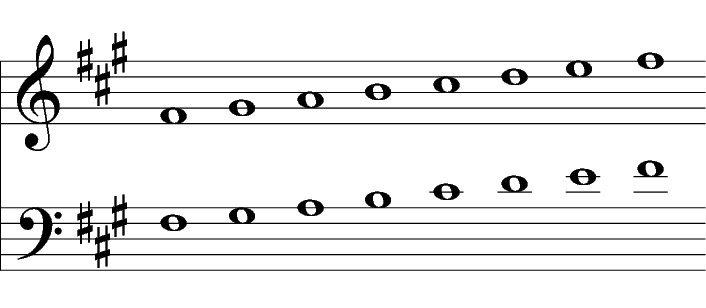
E major and C sharp natural minor
Figure 8-13 shows the E major key signature, and Figure 8-14 shows the C sharp natural minor key signature, E’s relative natural minor.
Figure 8-13: The E major key signature and scale.

Figure 8-14: The C sharp natural minor key signature and scale.
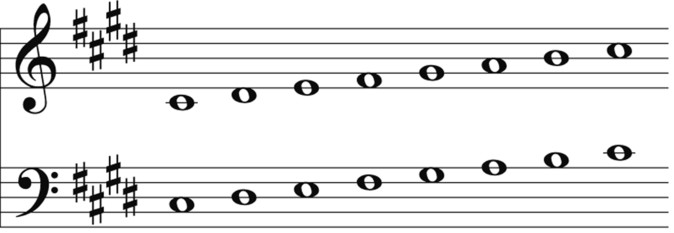
B/C flat major and G sharp/A flat natural minor
Figure 8-15 shows the B major key signature and C flat major key signature. Figure 8-16 shows the G sharp natural minor key signature and the A flat natural minor key signature.
Figure 8-15: The B major and C flat major key signatures and scales.

Figure 8-16: The G sharp natural minor and A flat natural minor key signatures and scales.

Confused by the double naming here? Take a look at a keyboard, and you see that a black key doesn’t exist for C flat. Instead, you see a white key: B. C flat and B are enharmonic equivalents of one another, meaning they’re the same but with different names. All the notes in the key of B major and the key of C flat major sound exactly the same — they just use different musical notation. The same goes for G sharp natural minor and A flat natural minor — same notes, just different notation.
F sharp/G flat major and D sharp/E flat natural minor
Figure 8-17 shows the F sharp major key signature and the G flat major key signature. Figure 8-18 shows the D sharp natural minor key signature and the E flat natural minor key signature. More enharmonic equivalents!
Figure 8-17: The F sharp major and G flat major key signatures and scales.

Figure 8-18: The D sharp natural minor and E flat natural minor key signatures and scales.

C sharp major/D flat and A sharp/B flat natural minor
Figure 8-19 shows the C sharp major key signature and the D flat major key signature. Figure 8-20 shows the A sharp natural minor key signature and the B flat natural minor key signature.
Figure 8-19: The C sharp major and D flat major key signatures and scales.

Figure 8-20: The A sharp natural minor and B flat natural minor key signatures and scales.

A flat major and F natural minor
Figure 8-21 shows the A flat major key signature and the F natural minor key signature, which is A flat’s relative natural minor.
Figure 8-21: The A flat major and F natural minor key signatures and scales.

E flat major and C natural minor
Figure 8-22 shows the E flat major key signature and the C natural minor key signature, which is E flat’s relative natural minor.
Figure 8-22: The E flat major and C natural minor key signatures and scales.

B flat major and G natural minor
Figure 8-23 shows the B flat major key signature and the G natural minor key signature, which is B flat’s relative natural minor.
Figure 8-23: The B flat major and G natural minor key signatures and scales.

F major and D natural minor
Figure 8-24 shows the F major key signature and the D natural minor key signature, which is F major’s relative natural minor.
Figure 8-24: The F major and D natural minor key signatures and scales.


 Each of the circle’s 12 stops is actually the fifth pitch in the scale of the preceding stop, which is why it’s called the Circle of Fifths. For example, the fifth pitch, or the
Each of the circle’s 12 stops is actually the fifth pitch in the scale of the preceding stop, which is why it’s called the Circle of Fifths. For example, the fifth pitch, or the 